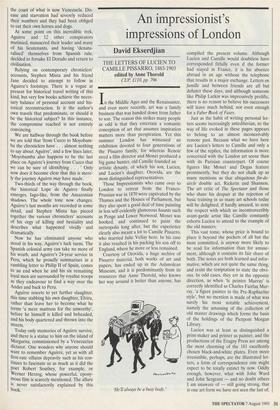An impressionist's impressions of London
David Ekserdjian
THE LETTERS OF LUCIEN TO CAMILLE PISSARRO, 1883-1903 edited by Anne Thorold CUP, .f110, pp. 796 In the Middle Ages and the Renaissance, and even more recently, art was a family business that was handed down from father to son. The reason this strikes many people as odd is that they entertain a romantic conception of art that assumes inspiration matters more than perspiration. Yet this summer London has witnessed an exhibition devoted to four generations of the Pissarro family, for whereas Renoir sired a film director and Monet produced a big game hunter, old Camille founded an artistic dynasty, of which his son, Lucien, and Lucien's daughter, Orovida, are the most distinguished representatives.
Those Impressionists who came over to London to retreat from the Franco- Prussian war in 1870 were captivated by the Thames and the Houses of Parliament, but they also spent a good deal of time painting in less self-evidently glamorous haunts such as Penge and Lower Norwood. Monet was hooked, and continued to paint the metropolis long after, but the experience clearly also meant a lot to Camille Pissarro, who married Julie Vellay here. In his case it also resulted in his packing his son off to England, where he more or less remained. Courtesy of Orovida, a huge archive of Pissarro material, both works of art and papers, has ended up in the Ashmolean Museum, and it is predominantly from its resources that Anne Thorold, who knows her way around it better than anyone, has 'He'll always be a busy body.' compiled the present volume. Although Lucien and Camille would doubtless have corresponded fitfully even if the former had stayed in France, it is his absence abroad in an age without the telephone that results in a major exchange. Letters en famille and between friends are all but defunct these days, and although someone like Philip Larkin was impressively prolific, there is no reason to believe his successors will leave much behind, not even enough for a Faber Book of Faxes.
Just as the habit of writing personal let- ters seems increasingly antediluvian, so the way of life evoked in these pages appears to belong to an almost inconceivably remote past. Because what we have here are Lucien's letters to Camille and only a few of the replies, the information is more concerned with the London art scene than with its Parisian counterpart. Of course figures like Monet and Degas feature prominently, but they do not chalk up as many mentions as that ubiquitous fin-de- siecle double act, Ricketts and Shannon. The art critic of The Spectator and those who share his despair at the rejection of basic training in so many art schools today will be delighted, if hardly amazed, to note the respect with which an incontrovertibly avant-garde artist like Camille constantly exhorts Lucien to attend to the example of the old masters.
This vast tome, whose price is bound to place it beyond the pockets of all but the most committed, is anyway more likely to be read for information than for amuse- ment, although it contains its fair share of both. The notes are both learned and infor- mative, which are not quite the same thing, and resist the temptation to state the obvi- ous. In odd cases, they err in the opposite direction, as when 'le peintre Murray' is correctly identified as Charles Fairfax Mur- ray, 'a figure painter in the Pre-Raphaelite style', but no mention is made of what was surely his most notable achievement, namely the amassing of the collection of old master drawings which forms the basis of the holdings of the Pierpont Morgan Library.
Lucien was at least as distinguished a print-maker and printer as painter, and the productions of the Eragny Press are among the most charming of the 181 excellently chosen black-and-white plates. Even more irresistible, perhaps, are the illustrated let- ters, a form of correspondence one might expect to be totally extinct by now. Oddly enough, however, what with John Ward and John Sergeant — and no doubt others I am unaware of — still going strong, that is one art form we have not seen the last of.


















































 Previous page
Previous page